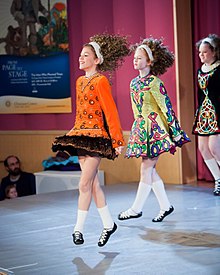
Back رقص ايرلندى ARZ Irski step Croatian Ír sztepp Hungarian Ierse stepdance Dutch Step irlandzki Polish Ирландские сольные танцы Russian අයර්ලන්ත ස්ටෙප් නර්තනය Singhalese İrlanda step dansı Turkish
This article possibly contains original research. (April 2017) |
| Irish Step Dance | |
|---|---|
 Irish dancers performing at a show (2010) | |
| Medium | Dance |
| Types | Performance and Competition |
| Ancestor arts | Irish dance |
| Originating culture | Irish |
| Originating era | Mid-1800s |
Irish stepdance is a style of performance dance with its roots in traditional Irish dance. It is generally characterized by a stiff upper body and fast and precise movements of the feet. It can be performed solo or in groups. Aside from public dance performances, there are also stepdance competitions all over the world. These competitions are often called Feiseanna (singular Feis). In Irish dance culture, a Feis is a traditional Gaelic arts and culture festival. Contemporarily, costumes are considered important for stage presence in competition and performance Irish stepdance. In many cases, costumes are sold at high prices and can even be custom made. Each costume is different, with varying colors and patterns, designed to attract the judge's eye in competitions and the audience's eye in performance. General appearance beside the costume is also equally important. Female dancers would typically curl their hair before each competition or wear curled wigs, while male dancers would neatly style their hair to a shape to their liking. Poodle Socks are worn by female dancers while males wear plain black socks. Poodle socks are white socks that stretch to typically 1-4 inches above the ankle, depending on the dancers preference. They also have distinctive ribbing, and can be embroidered with gems. This hyper-stylization originated in the Irish diaspora. Traditional costume was homemade or from the local dressmaker and embroidered with Celtic knots and designs.
Riverdance, an Irish step-dancing performance in the 1994 Eurovision Song Contest that later became a hugely successful theatrical production, greatly contributed to its popularity. Once Riverdance became a large production, it changed the way that Irish dance was performed and viewed. Now that entrepreneurs could capitalize on Irish culture, they were able to tweak it to the audience's liking. This meant adding a theatrical flair to the performance, including arm movements (as opposed to the previously rigid top half that dancers maintained) as well as sexualizing the dance and the costumes. To many, this was a betrayal of tradition, but to some, it was a way of expanding Irish culture and became widely accepted. Following after Riverdance was Lord of the Dance and many other theatrical productions based on Irish stepdance. Michael Flatley, an Irish stepdancer, became a well-known name within these shows.
Two types of shoes are worn in Irish stepdance; hard shoes, which make sounds similar to tap shoes, and soft shoes (called Ghillies), which are similar to ballet slippers. The dances for soft shoe and hard shoe are different and go by different names. Different music with varying beats are played based on the dance, though each soft and hard shoe dances all share basic moves and rhythms.